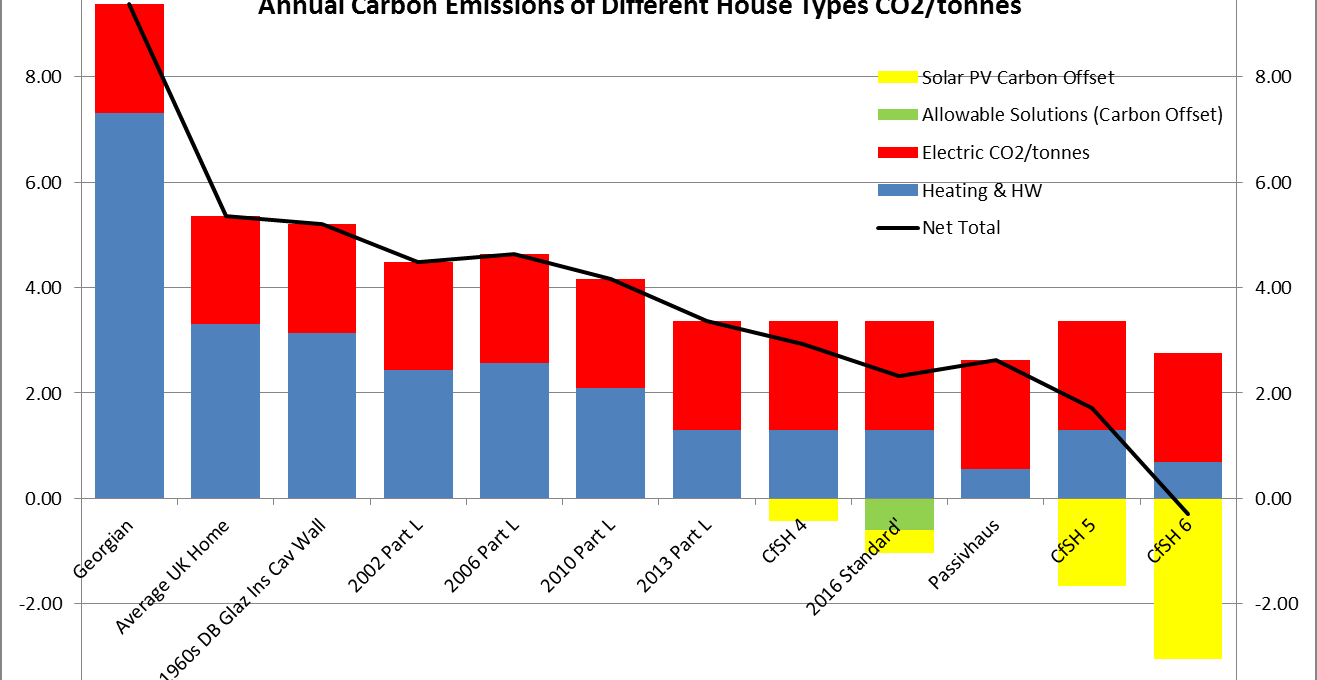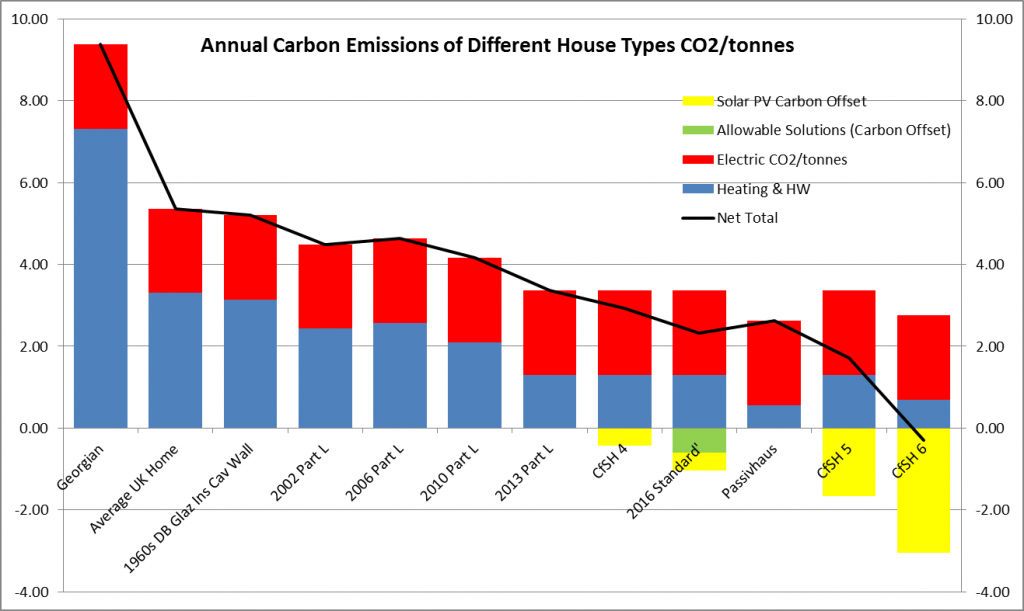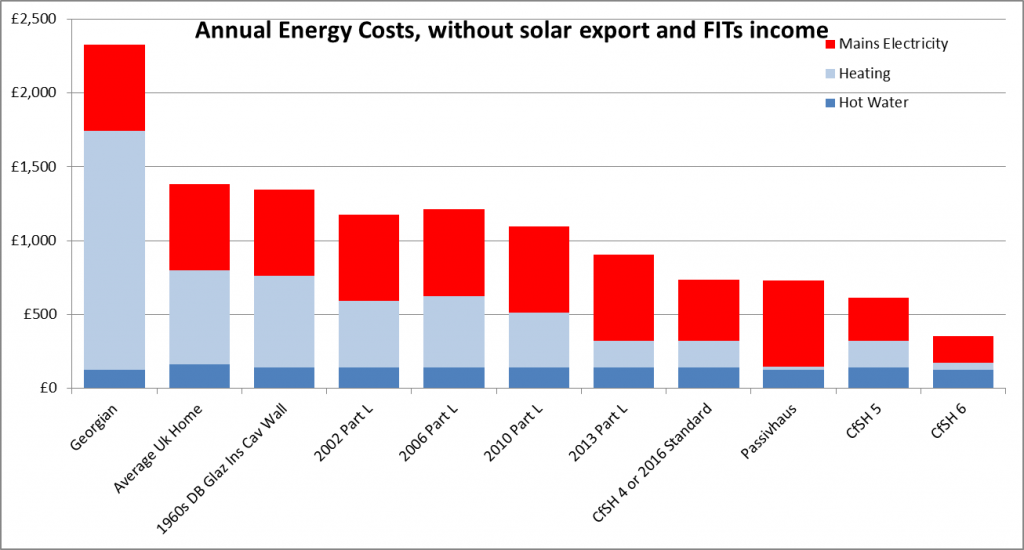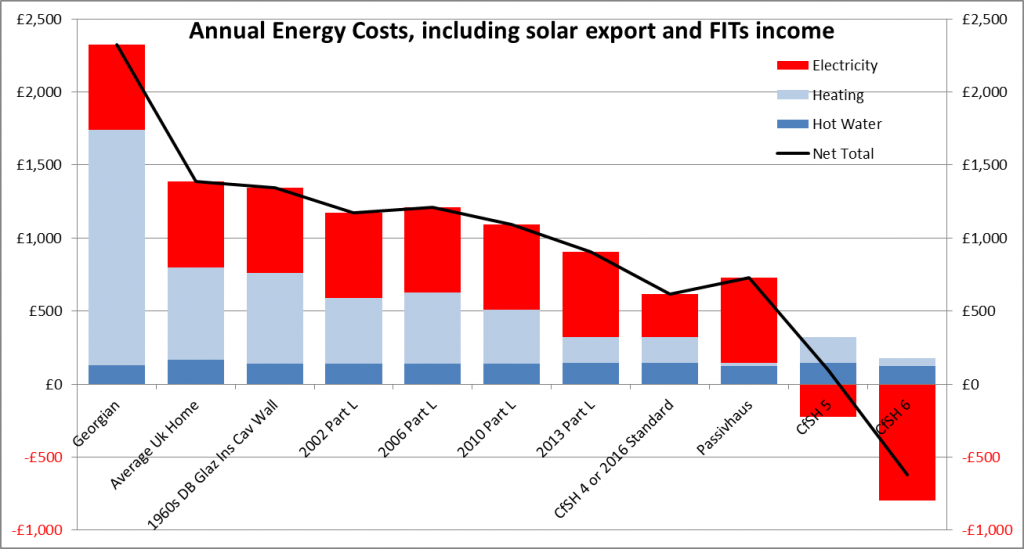
Summary
Transition Bath supports the building of more sustainable homes. This is a statement which 98% of the residents of Bath agreed with in our housing survey of April 2014. Although the energy efficiency of new homes has been gradually improving over the last few years, it is often difficult to understand the impact of these improvements, particularly as government impact analysis of the regulatory changes tend to ignore the benefits to consumers. Given the government’s proposed 2016 Zero Carbon housing was outlined in this month’s (June 2014) Queens Speech, and that the Planning Inspector is ruling on the Sustainable Construction component of B&NES Council’s Core Strategy this month, we thought it would be an apt time to look at the impact of both past and future standards on energy bills and CO2 emissions.
The graph below shows the impact on annual energy costs of past and future standards for an average 3 bed semi-detached home:
Improving standards have led to reduced energy costs, the ‘Average UK Home’ has an energy bill of £1,400 per year, but a new home built today using 2013 standards would only have a bill of £900. B&NES council have been trying to persuade builders, at an additional capital cost of about £8,000 to build homes to Code for Sustainable Homes level 5 (CfSH 5), this reduces bills significantly to about £100 per year, but unfortunately proposed changes in government regulation might stop them doing this.
Similarly, improving standards reduce CO2 emissions:

Our Georgian, solid-walled, single glazed homes have particularly high carbon emissions at almost 10 tonnes/year. Newly constructed homes have emissions of about 3.5 tonnes per year, but the CfSH 5 standard B&NES council have been requesting reduces this to only 1.5 tonnes per year. By 2050 it is reckoned that all UK homes will have to be retrofitted to produce less than 1 tonne/year.
However, the government’s proposed 2016 standard announced in the Infrastructure Bill, with annual carbon emissions of about 2.3 tonnes/year is a long way from zero carbon and significantly above the 1.7 tonnes of CfSH 5. There is also the risk that the 2016 proposals will get significantly watered down by the time the Infrastructure Bill is enacted.
Given Transition Bath’s objective is to make the city more sustainable, we think it important that both the government and our council continue to improve standards which reduce CO2 emissions and energy bills. It is something we will continue to push for, because if it is left completely under the influence of large builders our homes would not be getting more efficient, energy bills would be increasing as a result of energy prices and CO2 emissions would continue to rise.
If you have any further questions about these figures, please contact us at energy@transitionbath.org .
Detail
Background
On Wednesday 4th June 2014 the ‘Infrastructure Bill’ was announced in Parliament as part of the Queens’s Speech. The bill among other things lays forth the government’s strategy for zero carbon housing. Since this is something Transition Bath believes is an important component of our objective of reducing carbon emissions we thought it might be useful to look the potential impact of this bill.
History
Building Regulations: Since 2006 the government has gradually been tightening the part of Building Regulations ‘Part L’ which deals with the energy efficiency of new homes. In 2006 it set the UK the objective of achieving zero carbon homes by 2016. Originally a ‘Zero Carbon Home’ was defined as one which had no net carbon emissions. In 2011 the government relaxed the definition of ‘Zero Carbon’ in homes as part of the March 2011 budget, weakening it by removing the need for it to be carbon neutral for ‘unregulated electricity’. Unregulated electricity is the electricity consumption in a home associated with items not sold as part of the home – for example televisions but not lighting which is ‘regulated electricity’. This was quite a significant reduction in the target, at the time 2010 Part L homes emitted about 4.0 tonnes of carbon per year, a true zero carbon home emits 0.0 tonnes of carbon per year, but by removing the needed to assess unregulated electricity the target rose by about 1.7 tonnes.
Code for Sustainable Homes (CfSH): In parallel with Building Regulations, a new standard called ‘Code for Sustainable Homes’ was developed to promote more sustainable standards. Many local authorities used this as a basis for requiring builders to build homes above that required by minimum building regulations. The standard has a number of levels including level 4 (just above current building regulations), 5 (zero carbon apart from unregulated electricity) and level 6 (fully zero carbon). Bath Council, until recently was asking developers to build to level 4 or level 5. In 2013 the coalition government announced as part of the Deregulation Bill that it was intending to scrap the Code for Sustainable Homes and remove councils’ ability to specify higher standards. Its justification was that this would reduce red tape and allow more homes to be built, something Transition Bath would dispute.
Zero Carbon Standards and Allowable Solutions: Between 2012 and 2014, the government via an NGO called Zero Carbon Hub started examining cost effective ways of meeting the proposed 2016 Zero Carbon standard. This exercise was largely one of exploring how to most cost-efficiently meet the proposed standard. One of the ‘innovations’ of this process was ‘Allowable Solutions’– which is a mechanism which will allow builders to offset the carbon they can’t economically offset on site, for example where there isn’t enough roof space for solar panels. Originally a realistic carbon offset price of £120/tonne to be invested in local carbon reduction projects e.g. retrofitting local existing homes, was proposed. However, following a consultation on Allowable Solutions (which is still in progress, as of June 2014) it looks as though the proposal will be significantly watered down. Under pressure from the big builders, unrealistically low carbon prices of £36/tonne and removal of the requirement to deliver the offset carbon savings locally are being proposed.
Infrastructure Bill 2015: The regulatory framework for ‘Zero Carbon Homes’ was announced in the Queen’s Speech in June under the Infrastructure Bill, which is due to be enacted just before the next general election in May 2015. The details are a little vague at the moment but the Zero Carbon Standard appears to be defined as ‘energy efficiency to CfSH 4 standards plus Allowable Solutions carbon offsets to CfSH 5 standard’. Small builders will be exempt from these higher standards. The announcement is a little confusing as the government has announced its intention to abolish the Code for Sustainable Homes, but is then defining the new standard in terms of the Code for Sustainable Homes?
The carbon impact of these standards
This graph illustrates the impact on CO2 emissions of homes built to both past and future standards:

Comments on graph:
- New building regulations have gradually reduced the carbon emissions of homes
- An average new home built today under building regulations 2013 Part L will have theoretical annual carbon emissions of 3.4 tonnes compared with the average UK home’s 5.4 tonnes, a 35% reduction
- The 2016 standard which includes Allowable Solutions further reduces this to 2.3 tonnes, so about a 50% reduction on the average UK home
- We have assumed that the carbon price of Allowable Solutions will be watered down to such an extent that it will only offset about 50% of the carbon required and hence the 2016 standard does not match the CfSH 5 standard
- The 2016 standard is clearly not ‘Zero Carbon’, only the ‘CfSH 6 is
Cost Impact of these standards
As these standards improve, the energy cost of occupying new homes should reduce. The following 2 graphs illustrate this, the first excludes the income derived from exported electricity and the Feed-In-Tariff (FITS) from Solar PV and the second includes this income:

Comments on graph:
- The first graph illustrates the potential annual costs of an occupant renting a home to the given standard i.e. it is assumes the landlord derives the benefit from the export of electricity from solar PV panels and FITS
- It is assumed, given the government’s statement about the ‘2016 standard’ that its energy costs are equivalent to that of Code for Sustainable Homes Level 4 (CfSH 4)
- For someone renting a home, moving from an ‘average UK home’ to a new ‘2016 standard’ home might expect to see energy bills reduced from about £1385/year to £628/year a 55% reduction
The second graph is from an owner- occupier perspective i.e. they can derive income from Solar PV FITs and electricity export:

Comments on graph:
- The negative electricity costs for the CfSH 5 and CfSH 6 homes include the offset from income derived from solar PV
- Because of the potential income from exporting electricity and FITs, homes built to the CfSH 5 standard have almost no next energy costs (£100), and homes built to the higher CfSH 6 standard actually have a net income of £600 per year from their energy ‘bill’
- Investing in building fabric without investing in renewables (solar PV) provides diminishing returns because the hot water and electricity consumption are not reduced by investing solely in better fabric. Passivhaus’s, although they have virtually zero heating costs have higher energy bills than CfSH 4 homes because CfSH 4 homes’ solar PV reduces mains electricity consumption and income is derived from the Feed-In-Tariff
The impact on CO2 emissions of these new standards on Bath
If we assume that the amendment to the Deregulation Bill fails and that the new 2016 ‘Zero Carbon Standard’ doesn’t come into effect then the impact on the 12,700 homes to be built in Bath over the next 15 years will be an increase of 27,000 tonnes of carbon per year or about 10 large wind turbines.
If however the amendment fails, the Planning Inspector rules against CfSH 5 but the 2016 standard does come into effect then the impact will be much less at 7,000 tonnes CO2/year or about 3 wind turbines.
Conclusion
We feel that regulation, and in particular housing energy efficiency regulation is an important tool to force builders to build to higher standards. These higher standards not only reduce carbon emissions but reduce householders’ energy bills and fuel poverty. Although, in principle reducing regulation can be a good thing, it often leads to market failures, a good example is the lack of ‘space standard’ regulations in the UK, which has led to the smallest new build houses in Europe.
Background to calculations
All the figures presented in this article were independently derived by Transition Bath using SAP models for a 3 bed semi-detached home of 92m2. The calculations don’t take into account the performance gap between the theoretical SAP model and actual consumption.